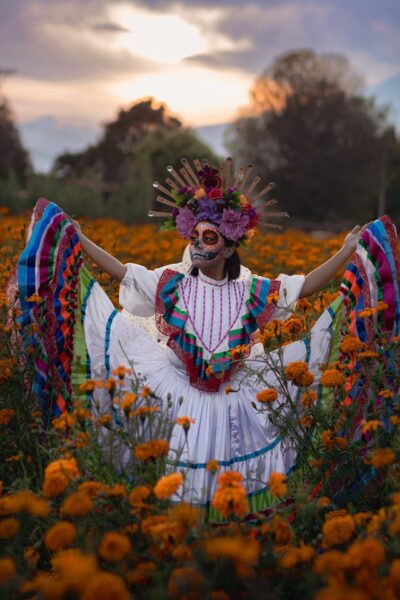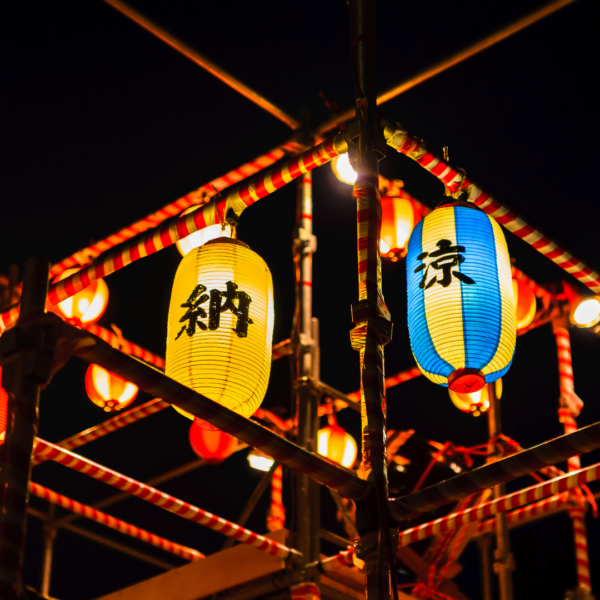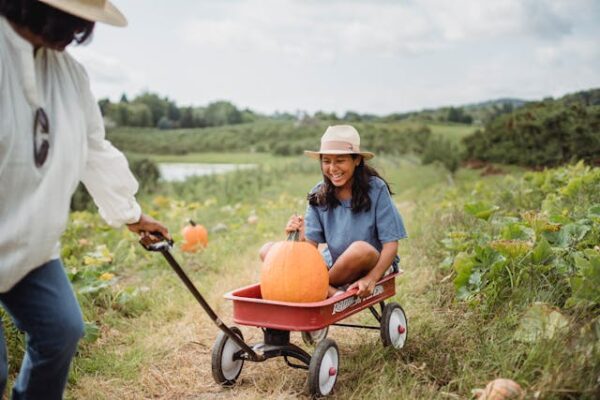The crisp breeze in the air is back, the days are getting shorter, and nature is showing off with all it’s vibrant colors—at least if you’re living somewhere in the northern hemisphere! As autumn rolls in, many cultures take a moment to reflect on life and honor those we’ve lost. Sure, Halloween with its jack-o’-lanterns and trick-or-treaters is a big deal in many western countries, but other cultures have their own unique festivals that celebrate similar themes of remembrance and community.
From Mexico’s colorful Día de los Muertos to Japan’s lantern-lit Obon, these celebrations remind us that life—and death—are all part of the journey. But where do words like “Halloween” or “spooky” come from? And why do we yell “boo!”? Let’s have a look at how different communities celebrate life and death around the world, plus uncover the stories behind some of our favorite Halloween words.

The Origin of Halloween: A Blend of Cultures
The word “Halloween” comes from “All Hallows’ Eve,” which is just a fancy way of saying “the night before All Saints’ Day” (that’s November 1st, by the way). “Hallow” is old-school English for “holy,” and “even” just means “evening.” People got lazy with the name over time, shortening it to “Hallowe’en” and finally “Halloween.”
This name change tells us a lot about Halloween’s mixed-up roots. It’s a mash-up of old pagan parties and Christian traditions. Way back when, the Celts had this festival called Samhain (pronounced “sow-in,” don’t ask us why). It was all about saying goodbye to summer and hello to winter. During Samhain, people thought the line between our world and the spirit world got super thin and they believed ghosts could pop over for a sneaky visit.
Pretty spooky, right? As Christianity spread, it kind of absorbed these old beliefs, turning them into the Halloween we know today.
Other Halloween-Related Words
- Spooky: This word is derived from “spook,” which refers to a ghost or apparition. Borrowed from Dutch spook, it first appeared in American English in 1801 and evolved into its current form by the mid-1800s.
- Haunt: Originating from the French verb hante-r, which means to frequent a place habitually, “haunt” has taken on a more supernatural meaning over time, referring to being troubled by ghosts or spirits.
- Pumpkin: The word “pumpkin” has its origins in Middle English as pompion, borrowed from French pompon. It ultimately traces back to ancient Greek pepōn, meaning “large melon.” The modern term emerged through linguistic evolution in English.
- Boo: Its origins can be traced back to the early 15th century, where it was used as an interjection to create a loud and startling sound. The term likely derives from the Latin word boāre, meaning “to cry aloud, roar, or shout,” and is also compared to the Greek word βοάω (boáō), which means “to shout”. Initially, “boo” was not primarily associated with scaring people; rather, it was used to assert one’s presence. For example, the Scottish proverb “He can’t say bo to a goose” refers to someone who is timid or lacks courage. The use of “boo” as a way to frighten others became more prominent over time, particularly in the 18th century when it was noted as a word used in Scotland to scare children
The Day of the Dead: A Colorful Celebration in Mexico
In Mexico, the Day of the Dead (Día de los Muertos) is a lively and colorful festival that honors those who have passed away. Celebrated on November 1st and 2nd, this two-day event is all about joyfully reconnecting with loved ones who are no longer with us.

What Makes Día de los Muertos Special?
- Ofrendas: Families create beautiful altars adorned with photos, favorite foods, and personal mementos of their departed relatives. It’s a heartfelt way to remember and celebrate their lives.
- Marigolds: These bright orange flowers are believed to guide spirits back to the living world. Their vibrant color symbolizes the beauty of life.
- Sugar Skulls: Colorful sugar skulls are not just decorations; they represent the sweetness of life and serve as a reminder that death is part of our journey.
Unlike Halloween’s spooky vibes, Día de los Muertos is all about celebrating life and cherishing memories. Families gather to share stories, laughter, and love, keeping the spirit of their ancestors alive.
Obon: Japan’s Heartfelt Lantern Festival
Another festival that beautifully captures themes of remembrance is Obon, celebrated in Japan during mid-August. This traditional event honors the spirits of ancestors and is deeply rooted in Buddhist beliefs.

Key Traditions of Obon:
- Bon Odori: Communities come together to dance in joyful celebrations, welcoming back the spirits of their loved ones. These dances are not only fun but also a way to express gratitude for ancestral guidance.
- Lanterns: Families light lanterns to guide spirits home. At the end of Obon, floating lanterns are often released into rivers or oceans as a heartfelt farewell.
- Family Gatherings: Obon is a time for families to unite, clean gravesites, and share meals in honor of their ancestors. It’s a beautiful way to strengthen family bonds and reflect on shared memories.
Obon emphasizes gratitude and connection, reminding us that our loved ones continue to influence our lives even after they’re gone.
Diverse Cultures, Common Ground
Sure, each of these celebrations has its own unique vibe and traditions, but they all share one thing in common: they invite us to hit pause and reflect on our past, honoring those who paved the way for us. Plus, let’s be honest—humans love a good excuse to throw a party! These gatherings are all about community, bringing people together in whatever way that may look. Ultimately, these festivals are here to remind us to celebrate the joy of living and the relationships that light up our lives.






